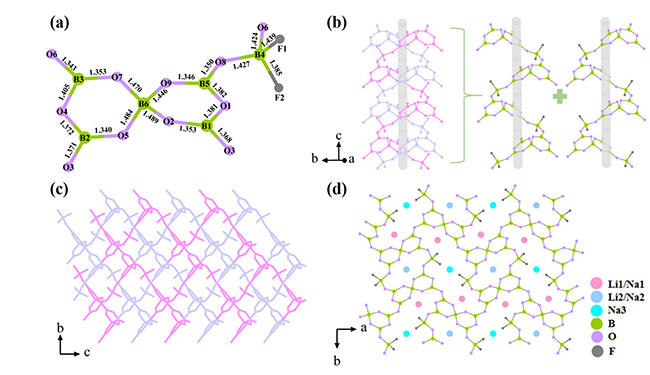Significance
Ultraviolet (UV) lasers find extensive applications in various commercial and scientific fields, such as ultrafast spectroscopy, UV processing, and UV disinfection. Nonlinear optical materials play a crucial role in these applications by enabling frequency conversion to extend the spectral range of lasers. For example, the fourth-harmonic generation (FHG) of Nd:YAG laser radiation using nonlinear optical (NLO) materials can produce 266 nm UV laser output. To meet the requirements of UV NLO materials, wide UV transparency, strong NLO efficiency, and the ability to achieve phase-matching at short wavelengths are essential. However, these requirements often pose conflicting demands, making the design of high-performance UV NLO materials a long-standing challenge. Indeed, designing materials that possess conflicting properties, such as wide UV transparency, strong NLO efficiency, and moderate birefringence for phase-matching at short wavelengths, has proven to be a complex task. However, a in new study by Professor Fangfang Zhang, and Professor Shilie Pan, et al, at the Xinjiang Technical Institute of Physics and Chemistry, Chinese Academy of Sciences, published in the peer-reviewed Journal Advanced Optical Materials, presents a promising approach to overcome these challenges. Their work explores the use of a fluorine-directed material design strategy, resulting in the synthesis of LiNaB6O9F2, a novel UV NLO crystal with enhanced birefringence and phase-matching capacity.
In previous research, the research team proposed a fluorine-directed material design strategy to explore birefringent and NLO materials in the borate system. This strategy leverages the introduction of fluorine into borates to enhance structural chemistry and regulate optical properties. The incorporation of fluorine into borates creates borate fluorides and fluorooxoborates, broadening the structural types and increasing the likelihood of achieving non-centrosymmetric structures. Additionally, oxyfluoride groups [BOxF4−x] exhibit greater polarizability anisotropy and hyper-polarizability compared to [BO4], resulting in improved birefringence and NLO efficiency. Moreover, [BOxF4−x] groups possess large HUMO-LUMO gaps, facilitating the generation of large band gaps and UV transparent materials.
To demonstrate the efficacy of the fluorine-directed strategy, the researchers focused on LiB3O5 (LBO), a well-known UV NLO material. While LBO possesses favorable properties, such as wide transparency and large SHG coefficients, it falls short in generating phase-matching SHG wavelengths below 266 nm due to its small birefringence. By introducing fluorine and reengineering the structure of LBO, the researchers successfully synthesized LiNaB6O9F2. This novel crystal exhibits fluorine-directed optimal performances, including a larger birefringence (0.067 at 1064 nm) and a blue-shifted phase-matching SHG wavelength (210 nm) compared to LBO (0.040 at 1064 nm and 277 nm, respectively).
The successful synthesis of LiNaB6O9F2 and its fluorine-directed optimal performances by the authors holds significant importance in the field of materials engineering and has wide-ranging applications. For instance, the development of high-performance UV NLO materials is crucial for various applications, including UV spectroscopy, UV processing, UV disinfection, and beyond. By successfully synthesizing LiNaB6O9F2 with enhanced birefringence and phase-matching capacity, the authors findings’ offers a pathway to overcome the long-standing challenge of combining conflicting properties required for UV NLO materials. The perfect balance achieved in LiNaB6O9F2, with a deep-UV cutoff edge, large SHG response (1.1 × KDP), and moderate birefringence (0.067 at 1064 nm), makes it a promising candidate for UV NLO crystals. This advancement opens up new possibilities for improving the performance and efficiency of UV lasers. Moreover, because UV lasers are essential for ultrafast spectroscopy techniques, enabling researchers to study ultrafast phenomena and dynamics in various materials and chemical reactions. The development of efficient UV NLO materials extends the accessible spectral range, enabling more comprehensive studies and improving the resolution and accuracy of ultrafast spectroscopy measurements. UV lasers are also used in various industrial processes, such as material ablation, micro-machining, and lithography. With the availability of advanced UV NLO materials such as LiNaB6O9F2, these processes can be performed with greater precision, higher power, and improved efficiency. This, in turn, contributes to advancements in manufacturing, electronics, and other industries reliant on UV processing technologies. Furthermore, because UV disinfection is a critical application in healthcare settings, water treatment facilities, and air purification systems. UV lasers can efficiently kill or inactivate microorganisms, including bacteria and viruses, by damaging their DNA or other vital components. The new UV NLO material, LiNaB6O9F2, may play a crucial role in enhancing the efficiency and effectiveness of UV disinfection systems, leading to improved public health and safety.
In conclusion, the authors presented in their study a significant advancement in the field of UV NLO materials. By employing a fluorine-directed material design strategy, they successfully synthesized LiNaB6O9F2, a promising UV NLO crystal that exhibits enhanced birefringence and phase-matching capacity. This work enriches the structural chemistry of fluorooxoborates and demonstrates the feasibility of the fluorine-directed strategy in exploring NLO crystals with excellent optical performances. The advancements made in UV NLO materials have the potential to revolutionize various applications, including ultrafast spectroscopy, UV processing, UV disinfection, and beyond. This research not only addresses the challenges of combining conflicting properties in UV NLO materials but also opens up new avenues for further technological advancements in the field.

Reference
Xiaojing Li, Zilong Chen, Fuming Li, Fangfang Zhang, Zhihua Yang, Shilie Pan. LiNaB6O9F2: A Promising UV NLO Crystal Having Fluorine-Directed Optimal Performances and Double Interpenetrating 3[B6O9F2]∞ Networks. Adv. Optical Mater. 2023, 11, 2202195
 Advances in Engineering Advances in Engineering features breaking research judged by Advances in Engineering advisory team to be of key importance in the Engineering field. Papers are selected from over 10,000 published each week from most peer reviewed journals.
Advances in Engineering Advances in Engineering features breaking research judged by Advances in Engineering advisory team to be of key importance in the Engineering field. Papers are selected from over 10,000 published each week from most peer reviewed journals.



